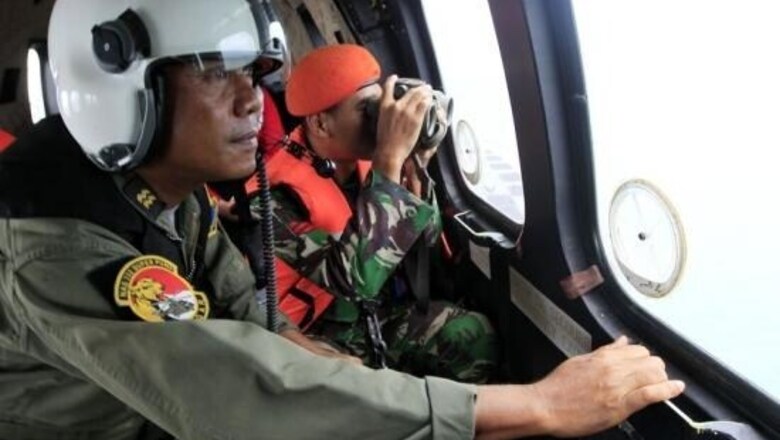
views
Indonesia: Aircraft combed the sea and shoreline off Borneo on Saturday for wreckage from an Indonesia AirAsia passenger jet, hoping to take advantage of a brief break in bad weather that has hampered efforts to find the plane and its black box flight recorders.
The Airbus A320-200 plunged into the Java Sea on Sunday while en route from Indonesia's second-biggest city Surabaya to Singapore with 162 people on board. No survivors have been found.
Indonesia's search and rescue agency said the search area had been widened on Saturday as debris from Flight QZ8501 may have drifted more than 200 nautical miles, adding helicopters would concentrate on searching the coastline of southern Borneo.
"With the strength of the winds, waves and current, we extended the search area to 210 nautical miles," Air Force Lt. Col. Johnson said.
Officials said 21 bodies were pulled from the sea on Friday, including two still strapped in their seat belts, bringing the total number of victims recovered to 30.
Small pieces of the aircraft and other debris have also been found, but there has been no sign of the crucial voice and flight data recorders - the so-called black boxes that investigators hope will unravel the sequence of events in the cockpit during the doomed jet's final minutes.
A multinational team of experts, including from France's BEA accident investigation agency that attends all Airbus crashes, has assembled at Pangkalan Bun, the town in southern Borneo closest to the search area.
But high winds and waves four metres (12 feet) high have prevented the use of some of the sophisticated equipment they have brought, including towed sonar devices and acoustic "pinger" locators designed to pick up signals from the black boxes.
Indonesia's weather bureau said rain was forecast in the search area later on Saturday, but there were hopes of clearer skies to aid the search in the morning.
Eight ships were on Saturday searching an area 35 nautical miles by 45 nautical miles in size thought to be the most likely resting place of the lost jet's fuselage.
Shallow seas
The cause of the crash, the first suffered by the AirAsia group since the budget operator began flying in 2002, is unexplained. Investigators are working on a theory that the plane stalled as it climbed steeply to avoid a storm about 40 minutes into a flight that should have lasted two hours.
Flight QZ8501 crashed in shallow seas, and experts say when the weather breaks finding the black boxes should not be difficult if the locator beacons, with a range of 2,000 to 3,000 metres (6,560 to 9,800 ft) and a battery life of about 30 days, are working.
"After the black box is found, we are able to issue a preliminary report in one month," said Toos Sanitioso, an investigator with the National Committee for Transportation Safety on Friday. "We cannot yet speculate what caused the crash."
The plane was flying at 32,000 ft (9,753 metres) and the pilot had asked to climb to 38,000 ft to avoid bad weather just before contact was lost. When air traffic controllers granted permission to fly at 34,000 ft a few minutes later, they got no response.
A source close to the investigation said radar data appeared to show the aircraft made an "unbelievably" steep climb before it crashed, possibly pushing it beyond the A320's limits.
Weather reports
Hadi Mustofa Djuraid, a Transport Ministry official, told reporters on Friday that authorities were investigating the possibility that the pilot did not ask for a weather report from the meteorological agency at the time of take-off.
Indonesia AirAsia said in a statement that weather reports were printed in hard copy at the operations control centre at all its flight hubs, including Surabaya, and taken by the pilot to the aircraft before each flight.
The Indonesian captain, a former air force fighter pilot, had 6,100 flying hours on the A320 and the plane last underwent maintenance in mid-November, according to Indonesia AirAsia, 49 percent owned by Malaysia-based AirAsia.
Indonesia's transport ministry said late on Friday it had temporarily suspended Indonesia AirAsia's Surabaya-Singapore flight because it had apparently operated the service beyond the duration of its licence.
"As of Jan. 2, 2015, the licence of Surabaya-Singapore (return) route to Indonesia AirAsia is temporarily frozen until after there is a result of evaluation and investigation," said spokesman Julius Adravida Barata.
Three airline disasters involving Malaysian-affiliated planes in under a year have spooked travellers.
Malaysia Airlines Flight MH370 disappeared in March en route from Kuala Lumpur to Beijing with 239 passengers and crew and has not been found. On July 17, the same airline's Flight MH17 was shot down over Ukraine, killing all 298 people on board.
On board Flight QZ8501 were 155 Indonesians, three South Koreans, and one person each from Singapore, Malaysia and Britain. The co-pilot was French.



















Comments
0 comment